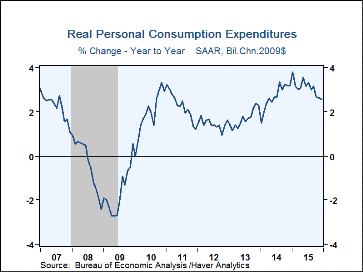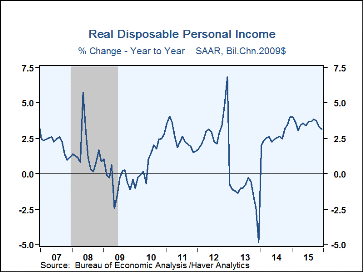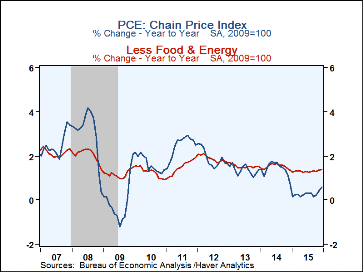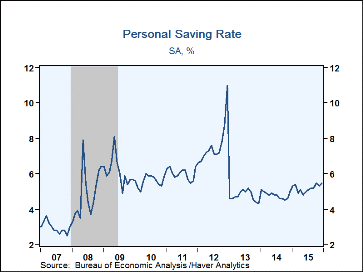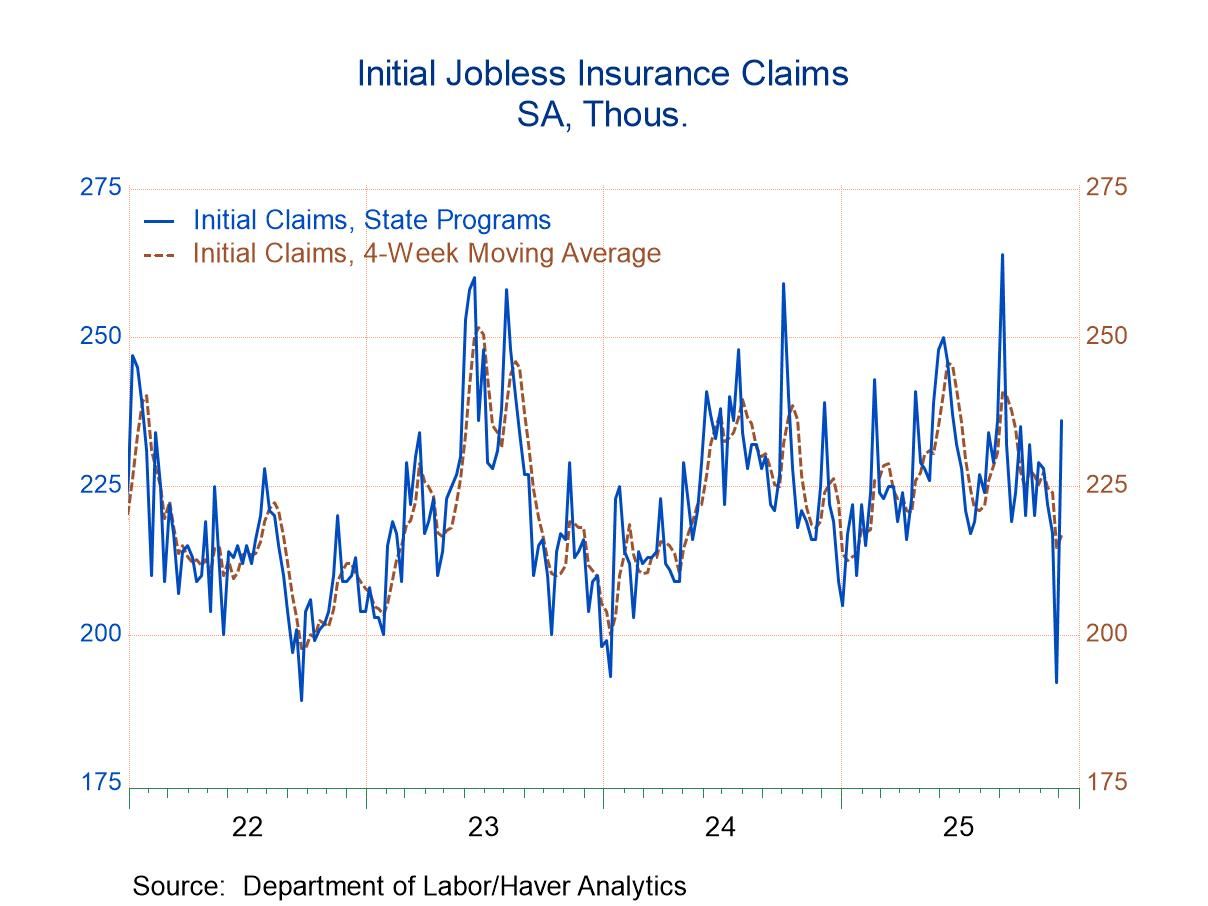 Global| Feb 01 2016
Global| Feb 01 2016U.S. Personal Spending Holds Steady Despite Income Increase
by:Tom Moeller
|in:Economy in Brief
Summary
Personal consumption expenditures were little changed during December (3.2% y/y) following a revised 0.5% November increase, initially reported as 0.3%. A 0.1% rise had been expected in the Action Economics Forecast Survey. When [...]
Personal consumption expenditures were little changed during December (3.2% y/y) following a revised 0.5% November increase, initially reported as 0.3%. A 0.1% rise had been expected in the Action Economics Forecast Survey. When adjusted for a slight dip in prices, spending rose 0.1% (2.6% y/y after a 0.4% increase. Notable caution was exhibited when it came to product spending. Durable goods purchases fell 0.9% (+3.5% y/y) following a 1.5% jump. Motor vehicle purchases were reduced 3.2% (+0.2% y/y), reversing all of the November surge. Home furnishing & appliance buying remained unchanged (3.6% y/y) after two months of 0.2% increase. Spending on recreational goods & vehicles edged up 0.1% (6.4% y/y) following six months of strong increase. In the nondurable goods sector, clothing purchases declined 0.7% (+0.8% y/y), off for the third month in the last four. Services spending picked up some of the slack with a second straight 0.4% rise (4.1% y/y). A 1.9% jump (4.7% y/y) in recreation services spending paced the increase. That was followed by a 1.0% gain (6.2% y/y) in hotels & restaurants. Lower energy prices afforded this strength as housing & utilities spending fell 0.2% (+2.9% y/y).
Cautious spending accompanied a moderate 0.3% rise (4.2% y/y) in personal income which followed an unrevised 0.3% gain. A 0.2% rise had been expected. Wage & salary earnings rose 0.2% (4.5% y/y) following a 0.5% rise. Rental income improved 0.5% (6.7% y/y), the strongest gain in six months. Transfer receipts jumped 0.7% (5.4% y/y), driven by a 1.4% rise (4.7% y/y) in social security payments. Medicare receipts improved 0.5% (4.6% y/y) for a third straight month. Jobless insurance benefits advanced 0.9% but they were off 8.5% y/y with the firmer job market. Proprietors earnings surged 1.0% (2.7% y/y) following a 0.1% dip. Dividend earnings fell minimally (+3.8% y/y) while interest earnings fell 0.7% (+1.5% y/y) for the third straight month.
Disposable personal income increased 0.3% (3.7% y/y) after a 0.2% gain. Adjusted for price inflation, take-home pay rose 0.4% (3.1% y/y) following three months of lesser increase.
The personal savings rate improved to 5.5% from 5.3%, earlier reported as 5.5%. The rate remained nearly the highest since 2012. Personal saving increased 15.3% during the last twelve months. During all of 2015, the personal savings rate averaged 5.2%, the highest level in three years.
The chain price index eased 0.1% (+0.6% y/y) after five months of little change. The index change was held back by a 0.7% fall (-2.5% y/y) in nondurable goods prices as energy costs declined 2.6% (-13.6% y/y), the fourth sharp decline in five months. Prices have fallen 24.8% since June 2004. Food prices fell 0.4% (-0.3% y/y) after a 0.2% decline. Excluding food & energy, prices remained unchanged (+1.4% y/y). Durable goods prices eased 0.1% (-1.4% y/y) while services prices improved 0.1% (1.9% y/y) after a 0.3% rise.
The personal income & consumption figures are available in Haver's USECON database with detail in the USNA database. The Action Economics figure is in the AS1REPNA database.
| Personal Income & Outlays (%) | Dec | Nov | Oct | Dec Y/Y | 2015 | 2014 | 2013 |
|---|---|---|---|---|---|---|---|
| Personal Income | 0.3 | 0.3 | 0.4 | 4.2 | 4.5 | 4.4 | 1.1 |
| Wages & Salaries | 0.2 | 0.5 | 0.6 | 4.5 | 4.8 | 5.1 | 2.7 |
| Disposable Personal Income | 0.3 | 0.2 | 0.3 | 3.7 | 3.8 | 4.2 | -0.1 |
| Personal Consumption Expenditures | -0.0 | 0.5 | 0.0 | 3.2 | 3.4 | 4.2 | 3.1 |
| Personal Saving Rate | 5.5 | 5.3 | 5.5 | 5.0 (Dec. '14) |
5.2 | 4.8 | 4.8 |
| PCE Chain Price Index | -0.1 | 0.1 | 0.1 | 0.6 | 0.3 | 1.4 | 1.4 |
| Less Food & Energy | 0.0 | 0.2 | 0.0 | 1.4 | 1.3 | 1.5 | 1.5 |
| Disposable Income | 0.4 | 0.2 | 0.2 | 3.1 | 3.5 | 2.7 | -1.4 |
| Real Personal Consumption Expenditures | 0.1 | 0.4 | -0.0 | 2.6 | 3.1 | 2.7 | 1.7 |
Tom Moeller
AuthorMore in Author Profile »Prior to joining Haver Analytics in 2000, Mr. Moeller worked as the Economist at Chancellor Capital Management from 1985 to 1999. There, he developed comprehensive economic forecasts and interpreted economic data for equity and fixed income portfolio managers. Also at Chancellor, Mr. Moeller worked as an equity analyst and was responsible for researching and rating companies in the economically sensitive automobile and housing industries for investment in Chancellor’s equity portfolio. Prior to joining Chancellor, Mr. Moeller was an Economist at Citibank from 1979 to 1984. He also analyzed pricing behavior in the metals industry for the Council on Wage and Price Stability in Washington, D.C. In 1999, Mr. Moeller received the award for most accurate forecast from the Forecasters' Club of New York. From 1990 to 1992 he was President of the New York Association for Business Economists. Mr. Moeller earned an M.B.A. in Finance from Fordham University, where he graduated in 1987. He holds a Bachelor of Arts in Economics from George Washington University.


